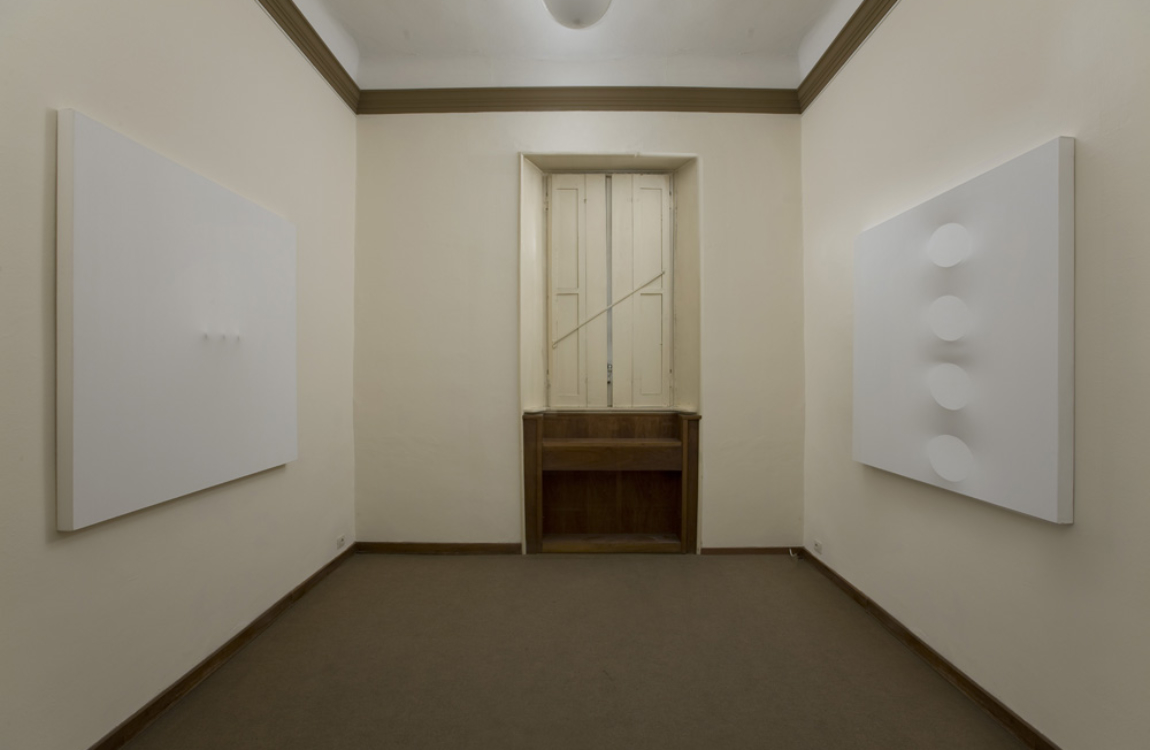Turi Simeti, QUADRI BIANCHI
Room 1
Presenting a work based on the reduction of sign, gesture and form, in recent years in which the proliferation and contamination of languages has often overloaded the visual perception of the artistic object, is a complex, not to say arduous undertaking. The extreme essentiality of Simeti’s lexicon could appear “stony” to an observer of this first decade of the 21st century. It then becomes necessary to recover the coordinates that define the Sicilian artist’s structural milieu, the underlying relationships with the great programmed and kinetic season of the early 1960s, up to the intimate, I would say, as well as personal interpretation of minimalism. The overcoming of the surface and of the gesture is manifested in the adoption of the repeated geometric element, at times similar to a family emblem, to an ancient emblem sculpted on the portal of a Sicilian noble palace. Going beyond the references to fantastic aesthetic values, residues of childhood memories, the oval shape adopted by Simeti seems to have a biological and organic essence. The cell as a primary constructive element germinates on the canvas almost as if to form an autonomous and self-referential visual organism. A method that characterises the Sicilian artist’s language from the early 1960s and, according to the critics, connects his research to the contemporary experiences of Castellani and Bonalumi. Unlike the latter, however, the spatial function in his reflections is, if not secondary, at least not load-bearing in the constructive framework of his work. The need to go beyond the two-dimensionality of the pictorial surface is not substantial, but is necessarily visual. In Simeti, the metaphysics of space is subordinate to the search for the essential; in fact, during the 1970s, although he does not renounce elipsoidal forms, he theorises their isolation. A profound and unique relationship is thus established between the monochrome canvas and the solitary shaped oval, which, like a puncture of the soul, leaves an existential trace on the surface.
Gianluca Brogna
Turi Simeti was born in Alcamo in the province of Trapani in 1929. He moved to Rome in the early 1960s and in 1965 to Milan, where he lives and works. In the Lombard capital he took part in the Zero Avantgardieexhibition in Lucio Fontana’s studio in 1965 and held his first personal exhibitions. Between 1966 and 1969, invited as Artist in Residence by Fairleigh Dickinson University, he spent long periods in New York. In 1971 he exhibited at the prestigious M Gallery in Bochum and from Löehr to Frankfurt. In the early 1970s he held solo and group exhibitions in Bergamo, Verona, Rottweil, Düsseldorf, Oldenburg, Köln, Munich, Basel and Koblenz. In 1980 the Pinacoteca Comunale of Macerata hosted a solo exhibition of his work and in the same year he opened a studio in Rio de Janeiro. His works were exhibited at the GaIerie Wack in Kaiserslautern in 1983, at the Galerie Maier in Kitzbüehl and at the Galerie Ahrens in Koblenz in 1984, at the Galeria Paulo Figueiredo in São Paulo, Brazil and at the Galerie 44 in Düsseldorf in 1985, at the Galerie Apicella in Bonn in 1986 and at the Galerie Monochrome in Aachen in 1987. In 1990 the exhibition 58-80 Bonalumi Castellani Simeti/Tre Percorsi was held at the Galleria Millenium in Milan. During the 1990s he exhibited in Rio de Janeiro, Biberach, Kaiserslautern, Milan, Bolzano and Trapani, at the Kunstverein in Ludwigsburg and in Erice. In 1998 he had a solo exhibition at the Galerie Kain in Basel and in 1999 he exhibited in Biberach, Ladenburg and Mannhein. In 2004 he held a personal exhibition at the Galleria Poleschi in Milan and in 2005 in Lugano at the ARTantide space. In 2006 he had two one-man shows at the BIM – Banca Intermobiliare Gallery in Lugano and at the Excalibur Gallery in Solcio di Lesa. He held an exhibition at the GlobArt Gallery in Acqui Terme in 2007 and in 2009 at the Maretti Arte Monaco in Monte Carlo. In the same year he created an installation of large white works at the Studio d’arte Contemporanea Pino Casagrande in Rome. In February 2010 he exhibited at the Salvatore + Caroline Ala Gallery in Milan.
Posted on: 17 November 2021, by : Alessandro Ulleri





